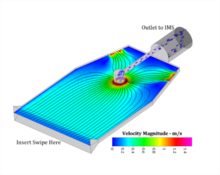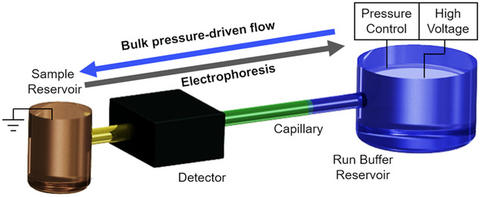Summary

NIST works to identify, research, and document improvements to current and next-generation detection systems. Emphasis is placed on performance characterization of widely-deployed ion mobility spectrometer systems, front-end development for ambient mass spectrometer platforms, and optimized testing methodologies for orthogonal detection systems, like Raman spectroscopy and electrophoretic systems. Current work is focused on development of technologies for detection of emerging thereat such as inorganic oxidizers.
Description
Ion Mobility Spectrometry (IMS) is widely used for national security and law enforcement, placed at key security checkpoints such as airports and border crossings for the trace detection of drugs and explosives. Its simplicity, ease of operation, portability, and rapid analytical performance provides a basis for its real-time screening capability. The technique is robust and can differentiate a wide range of drug and explosive molecules. But as new materials are added to the threat list the method can have difficulties. Therefore it is necessary to investigate ways to maintain or improve instrument performance by optimization of measurement parameters, like thermal desorption temperature and profiles.
It's also important to explore alternative or orthogonal methods to keep pace with the ever changing threat landscape. We have successfully investigated to use of novel electrophoretic methods to separate and detect trace explosive, demonstrating the detection of explosive fuel-oxidizer mixtures of intact and post-blast sample matrices.

Publications
"Inorganic oxidizer detection from propellants, pyrotechnics, and homemade explosive powders using gradient elution moving boundary electrophoresis", Krauss, S.T., Forbes, T.P. and Jobes, D., Electrophoresis, 42: 279-288 (2021). https://doi.org/10.1002/elps.202000279.
“Detection of fuel-oxidizer explosives utilizing portable capillary electrophoresis with wipe-based sampling”, Shannon T. Krauss, Thomas P. Forbes, Jeffrey A. Lawrence, Greg Gillen and Jennifer R. Verkouteren, Electrophoresis, 41,1482-1490 (2020). https://doi.org/10.1002/elps.202000094
“Emerging techniques for the detection of pyrotechnic residues from seized postal packages containing fireworks”, Karlijn D.B. Bezemer,, Thomas P. Forbes, Annemieke W.C. Hulsbergen, Jennifer Verkouteren, Shannon T. Krauss, Mattijs Koeberg, Peter J. Schoenmakers, Greg Gillen and Arian C. van Asten, Forensic Science International, 308, 110160 (2020). https://doi.org/10.1016/j.forsciint.2020.110160.
“Detection of Nonvolatile Inorganic Oxidizer-Based Explosives from Wipe Collections by Infrared Thermal Desorption—Direct Analysis in Real Time Mass Spectrometry”, TP Forbes, E Sisco and M Staymates, Analytical Chemistry, 90 (11), 6419-6425 (2018). https://doi.org/10.1021/acs.analchem.8b01037.

